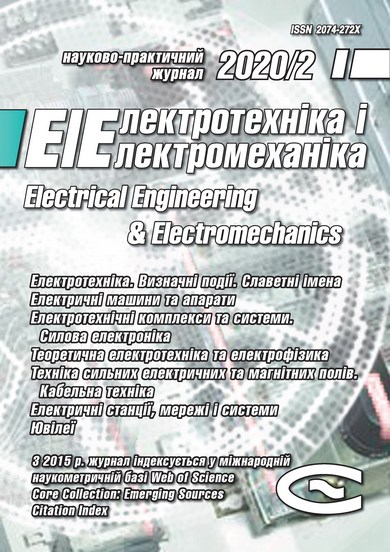CHARACTERISTICS OF A CYLINDRICAL INDUCTOR OF A ROTATING MAGNETIC FIELD FOR TECHNOLOGICAL PURPOSES WHEN IT IS POWERED FROM THE MAINS AT A GIVEN VOLTAGE
DOI:
https://doi.org/10.20998/2074-272X.2020.2.02Keywords:
three-phase cylindrical inductor, working chamber, ferromagnetic elements, rotating magnetic field, numerical calculations, load mode, stable voltage, electric, magnetic and energy parameters, phase shiftsAbstract
Introduction. A computational analysis of the characteristics of an inductor of a rotating magnetic field for technological purposes is presented. The design of its stator is borrowed from a three-phase induction motor. The cylindrical cavity inside the stator is occupied by a working chamber into which a granular or liquid processed substance is loaded. The processing is carried out with elongated ferromagnetic elements moving with a magnetic field. Problem. The purpose of the article is a study of the electromagnetic, phase, and energy characteristics of an inductor at its operation under load mode with a given voltage of the stator winding. Methodology. The study is performed on the basis of numerical calculations of the magnetic field, taking into account the anisotropy of the low-magnetic medium in the working chamber. Its discrete medium is represented homogeneous with different magnetic permeabilities on mutually perpendicular axes. The technique of transition from the results of the magnetic field calculation to the electric, magnetic, phase and energy parameters of the inductor is given. This is facilitated by the electrical equivalent circuit of the stator phase winding, the equilibrium equation of its electrical quantities, vector diagrams and an iterative method for determining the current at a given voltage. Results. Mutual dependencies of a number of inductor parameters are formed into a family of characteristics exhibiting its properties in an operating mode with a changing load. Characteristics include such quantities as magnetic flux linkage of the stator winding, its current and EMF, phase shifts between them, electromagnetic torque, expended and useful power and its losses, power factor and efficiency. In this article, a feature of this mode is the stability of the stator winding voltage in the inductor. This complements the earlier studies of the inductor in the mode with stabilization of the winding current, which allows to compare these options. On the example of a test sample of an inductor, a number of its characteristics are shown, vector diagrams of its electric and magnetic quantities illustrating their mutual phase shifts are given. Practical value. The presented technique for determining the electric and magnetic quantities of the inductor and their phase relationships, and also the shown family of characteristics can contribute to increasing the design efficiency and improving the inductors of the considered type. The developed technique has the universality property, as it is capable of displaying their various circuit and constructional design parameters.References
Chen L., Yang R., Zeng J., Shao Y., Xiao Q., Guo S. A wet belt permanent high gradient magnetic separator for purification of non-metallic ores. International Journal of Mineral Processing, 2016, vol. 153, pp. 66-70. doi: 10.1016/j.minpro.2016.06.004.
Ge W., Encinas A., Araujo E., Song S. Magnetic matrices used in high gradient magnetic separation (HGMS): A review. Results in Physics, 2017, vol. 7, pp. 4278-4286. doi: 10.1016/j.rinp.2017.10.055.
Wang Y., Gao D., Zheng X., Lu D., Li X. Rapid determination of the magnetization state of elliptic cross-section matrices for high gradient magnetic separation. Powder Technology, 2018, vol. 339, pp. 139-148. doi: 10.1016/j.powtec.2018.08.012.
Altın G., Inal S., Ibrahim A.L.P. Recovery of chromite from processing plant tailing by vertical ring and pulsating high gradient magnetic separation. MT Bilimsel, 2018, vol. 13, pp. 23-35.
Gerasimov M.D., Loktionov I.O. Dual-use technological solutions. Application prospects. Vektor GeoNauk, 2019, vol. 2, no. 1, pp. 19-26. doi: 10.24411/2619-0761-2019-10003.
Milykh V.I., Shilkova L.V. Experimental research of the three-phase physical model of the magnetic field inductor in the working mode when processing bulk material. Bulletin of NTU «KhPI». Series: «Electric machines and electromechanical energy conversion», 2020, no.3(1357), pp. 3-7. (Ukr). doi: 10.20998/2409-9295.2020.3.01.
Milykh V.I., Shilkova L.V. Numerical-field analysis of the characteristics of a three-phase magnetic field inductor for the treatment of various substances with current stabilization. Electrical engineering & electromechanics, 2019, no. 6, pp. 21-28. doi: 10.20998/2074-272X.2019.6.03.
Finite Element Method Magnetics: OldVersions. FEMM 4.2 11Oct2010 Self-Installing Executable. Available at: http://www.femm.info/wiki/OldVersions (accessed 15.06.2017).
Milykh V.I. The system of automated formation of electrical machines computational models for the FEMM software environment. Technical Electrodynamics, 2018, no.4, pp. 74-78. (Ukr.) doi: 10.15407/techned2018.04.074.
Downloads
Published
How to Cite
Issue
Section
License
Copyright (c) 2020 V. I. Milykh, L. V. Shilkova

This work is licensed under a Creative Commons Attribution-NonCommercial 4.0 International License.
Authors who publish with this journal agree to the following terms:
1. Authors retain copyright and grant the journal right of first publication with the work simultaneously licensed under a Creative Commons Attribution License that allows others to share the work with an acknowledgement of the work's authorship and initial publication in this journal.
2. Authors are able to enter into separate, additional contractual arrangements for the non-exclusive distribution of the journal's published version of the work (e.g., post it to an institutional repository or publish it in a book), with an acknowledgement of its initial publication in this journal.
3. Authors are permitted and encouraged to post their work online (e.g., in institutional repositories or on their website) prior to and during the submission process, as it can lead to productive exchanges, as well as earlier and greater citation of published work.





